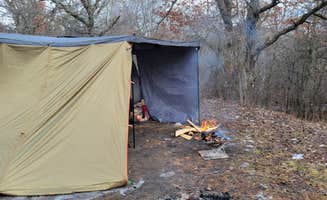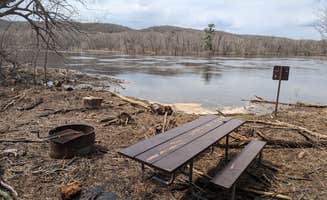Rustic camping near St. Louis Park, Minnesota provides access to primitive sites where temperatures range from summer highs of 83°F to winter lows below 8°F. The region features sandy soil conditions that drain quickly after rainfall, creating firm camping surfaces even after wet weather. Vehicle restrictions and seasonal closures affect accessibility throughout the year.
What to do
Bird watching opportunities: South of Sand Dunes State Forest offers diverse bird habitat with "quiet with lots of different bird sounds" according to Jason B., who noted the peaceful environment despite "some younger people coming through sporadically playing with their trucks." Many visitors report spotting sandhill cranes and other woodland species.
Hammock camping setups: The forested areas provide ideal trees for hammock suspension. Joslyn H. at South of Sand Dunes State Forest found "an incredible spot to camp and lay in my hammock" during a walk-in excursion, highlighting the accessibility of suitable sites within short hiking distance of parking areas.
Trail system exploration: Multiple interconnected paths wind through the sandy terrain. The St. Croix River area features the Ice Age Trail with "well managed gravel trail to the south and single wide footpath to the north" as described by Travis B. at Sandy Cove on the St. Croix River, making it suitable for day hikes from camp.
What campers like
Accessible wilderness feeling: Despite proximity to urban areas, the seclusion appeals to many campers. Skip H. reports that at South of Sand Dunes State Forest, "after 12 p.m., not much of anything" in terms of traffic disrupts the camping experience, creating a sense of isolation just an hour from metropolitan areas.
Vehicle-free zones: Many side roads are designated non-motorized, enhancing the backcountry experience. Adam W. notes that "a lot of the side roads are closed to motor vehicles due to some issues they had a couple years ago but are now taken care of" at South of Sand Dunes State Forest, creating quieter camping environments away from traffic.
Wheelchair accessibility options: Some sites provide modified facilities for visitors with mobility needs. Travis B. observed that at Sandy Cove, "the table has an extra long side for those in a wheelchair" and the "crushed gravel path to the south makes travel to the nearby Lions park easy," creating more inclusive camping options.
What you should know
Wildlife interactions: Local animals may approach campsites. Heather W. from South of Sand Dunes State Forest warns "sandhill storks are very protective. Stay away from them. They attack," highlighting the importance of maintaining distance from nesting birds.
Cell service limitations: Connectivity is inconsistent throughout the region. Alison O. describes the experience as "Nomad crew: Two humans, one adventure-seeking pup, zero bars on the phone," emphasizing the need to download maps and information before arrival.
Road conditions and traffic patterns: Gravel roads receive varying levels of maintenance and use. Ryan P. cautions that "this road is pretty busy for a dirt forest road and people FLY down it. Almost got hit a few times walking. Even through a Wednesday night cars are flying down the road," indicating that pedestrian awareness is necessary even midweek.
Tips for camping with families
Site selection strategies: Different locations offer varying degrees of privacy and features. Gregory found that at South of Sand Dunes State Forest, "most sites were shaded" and "several sites were by water," allowing families to choose between sun protection and water access.
Insect preparation requirements: Mosquitoes are prevalent, particularly at dusk and near water. Multiple campers mention bringing substantial insect repellent, with Gregory noting that "as to be expected, mozzies were present" and affected their decision to relocate after "5 mins of the door being opened and several flying in."
Advance preparation for no facilities: The lack of amenities requires thorough planning. Visitors to South of Sand Dunes State Forest emphasize bringing all necessary supplies including water, as Samuel C. confirms there are "no toilets, no water, no trash cans" at most dispersed sites.
Tips from RVers
Vehicle size limitations: RV access varies significantly by location and specific sites. Skip H. advises South of Sand Dunes is "best for straight vehicles or very small trailers" and notes that while there are "plenty of parking" options, most won't accommodate larger rigs.
Jurisdictional confusion: Different agencies enforce varying rules about camping vehicles. Jason B. warns about potential law enforcement interactions: "I had a county sheriff person tell me it's not lawful to park a trailer and they kicked me out. I called the DNR and they said that wasn't right but I decided to leave anyway," suggesting RVers confirm regulations with multiple agencies before setting up.
Low clearance challenges: Tree canopies may impact taller vehicles. Gregory experienced branches that "over hung, and rested on our camper (8ft high)" at South of Sand Dunes State Forest, forcing them to find another location despite initially liking the site.



